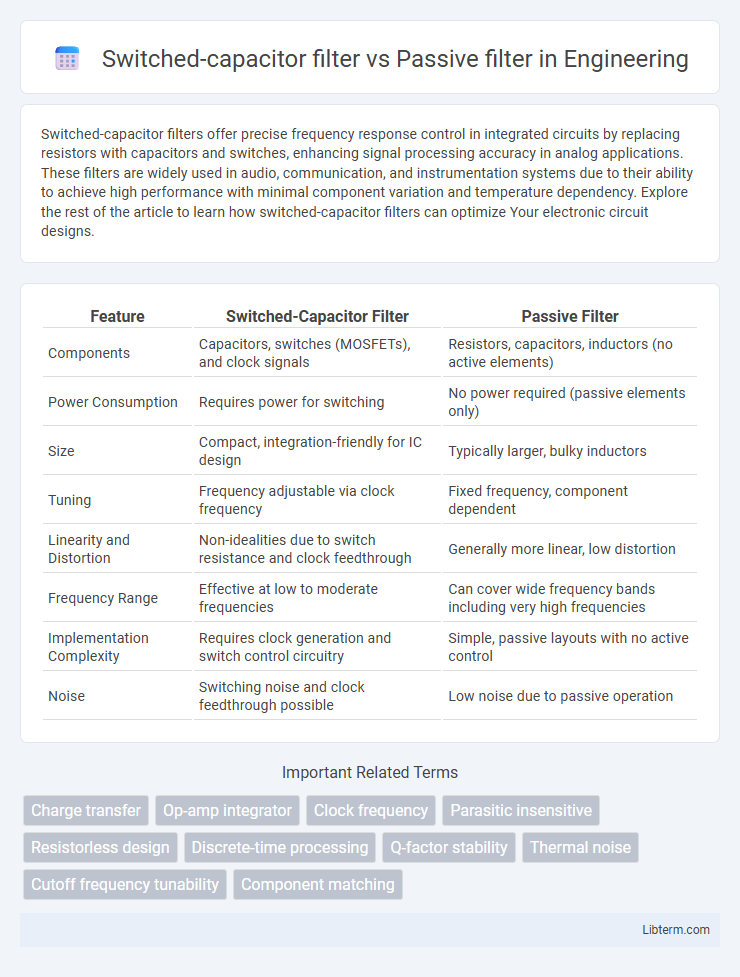Switched-capacitor filters offer precise frequency response control in integrated circuits by replacing resistors with capacitors and switches, enhancing signal processing accuracy in analog applications. These filters are widely used in audio, communication, and instrumentation systems due to their ability to achieve high performance with minimal component variation and temperature dependency. Explore the rest of the article to learn how switched-capacitor filters can optimize Your electronic circuit designs.
Table of Comparison
| Feature | Switched-Capacitor Filter | Passive Filter |
|---|---|---|
| Components | Capacitors, switches (MOSFETs), and clock signals | Resistors, capacitors, inductors (no active elements) |
| Power Consumption | Requires power for switching | No power required (passive elements only) |
| Size | Compact, integration-friendly for IC design | Typically larger, bulky inductors |
| Tuning | Frequency adjustable via clock frequency | Fixed frequency, component dependent |
| Linearity and Distortion | Non-idealities due to switch resistance and clock feedthrough | Generally more linear, low distortion |
| Frequency Range | Effective at low to moderate frequencies | Can cover wide frequency bands including very high frequencies |
| Implementation Complexity | Requires clock generation and switch control circuitry | Simple, passive layouts with no active control |
| Noise | Switching noise and clock feedthrough possible | Low noise due to passive operation |
Introduction to Switched-Capacitor and Passive Filters
Switched-capacitor filters utilize capacitors and switches driven by clock signals to emulate resistors, enabling precise and programmable frequency response without requiring inductors. Passive filters, comprising resistors, capacitors, and inductors, rely solely on passive components and operate without external power, often resulting in larger size and less tunability. The switched-capacitor design offers advantages in integrated circuits, such as improved accuracy and scalability, compared to traditional passive filters.
Fundamental Principles of Switched-Capacitor Filters
Switched-capacitor filters operate by emulating resistors through the rapid switching of capacitors at a fixed clock frequency, allowing precise control of filter characteristics without relying on resistor matching or process variations. They leverage discrete-time charge transfer, where capacitors are alternately connected and disconnected, effectively sampling and integrating input signals to achieve desired frequency responses. This fundamental principle enables switched-capacitor filters to provide accurate, tunable filtering in integrated circuits, outperforming passive filters that depend solely on physical resistor and capacitor values.
Basic Concepts of Passive Filters
Passive filters utilize only resistors, capacitors, and inductors to attenuate unwanted frequencies without requiring power sources, relying on their inherent impedance properties. They are categorized into low-pass, high-pass, band-pass, and band-stop filters, each designed based on the frequency-selective behavior of the reactive components. Switched-capacitor filters emulate resistor behavior using capacitors and switches controlled by clock signals, enabling precise filter characteristics in integrated circuits without inductors, which distinguishes them from passive filters.
Circuit Components and Design Complexity
Switched-capacitor filters utilize active components such as operational amplifiers and switches, allowing precise frequency control through capacitor switching, resulting in more complex circuit designs compared to passive filters. Passive filters rely solely on resistors, capacitors, and inductors, offering simpler circuits but limited tunability and less accuracy. The integration of active elements in switched-capacitor filters enables compact, monolithic designs ideal for integrated circuits, whereas passive filters remain bulkier due to discrete inductors and capacitors.
Frequency Response and Tunability
Switched-capacitor filters offer precise frequency response control through clock frequency adjustment, enabling high tunability without changing physical components. Passive filters, composed of resistors, capacitors, and inductors, have fixed frequency responses dictated by component values, limiting real-time tunability. Switched-capacitor filters provide superior integration in IC design and frequency agility, while passive filters excel in simplicity and low power consumption.
Power Consumption and Efficiency
Switched-capacitor filters typically consume more power due to the continuous switching action and active components like operational amplifiers, contrasting with passive filters that rely solely on resistors, capacitors, and inductors, resulting in almost zero power consumption. Passive filters offer higher efficiency in low-power applications since they do not require external power sources, whereas switched-capacitor filters provide better precision and tunability at the cost of increased power usage. In battery-powered or energy-sensitive systems, passive filters are preferred for their minimal power draw, while switched-capacitor filters are advantageous in integrated circuits demanding compact size and adjustable filtering characteristics despite higher energy consumption.
Size, Integration, and Cost Considerations
Switched-capacitor filters offer significantly smaller size and better integration capabilities compared to passive filters, as they rely on capacitors and active switches instead of bulky inductors. Their semiconductor fabrication allows seamless integration into integrated circuits, reducing overall system size and enhancing precision. However, switched-capacitor filters often incur higher initial design complexity and cost, while passive filters provide cost-effective, simple solutions with larger, discrete components suited for lower-frequency applications.
Noise Performance and Signal Integrity
Switched-capacitor filters offer improved noise performance compared to passive filters due to their active circuitry, which reduces thermal noise and allows for precise frequency control without inductors. They maintain signal integrity by minimizing signal attenuation and distortion through high-quality switched capacitor networks, ideal for low-level signal processing. Passive filters, while simpler and requiring no power, typically exhibit higher insertion loss and are more susceptible to noise and component tolerances, impacting overall signal fidelity.
Applications in Modern Electronics
Switched-capacitor filters offer precise frequency control and integration in integrated circuits, making them ideal for applications in digitized audio processing, telecommunications, and sensor signal conditioning. Passive filters, relying on resistors, capacitors, and inductors, are favored in RF circuits, power supplies, and audio systems for their simplicity and low noise characteristics. The choice between these filters hinges on requirements for tunability, integration capability, and frequency range in modern electronic designs.
Summary: Choosing Between Switched-Capacitor and Passive Filters
Switched-capacitor filters offer precise, programmable cutoff frequencies and are well-suited for integrated circuit implementation, providing high accuracy and stability without bulky inductors. Passive filters, composed of resistors, capacitors, and inductors, are simpler, consume no power, and are preferred in high-frequency or high-power applications where active components are limited. Selecting between switched-capacitor and passive filters depends on factors like frequency range, size constraints, power consumption, and desired filter precision.
Switched-capacitor filter Infographic

 libterm.com
libterm.com